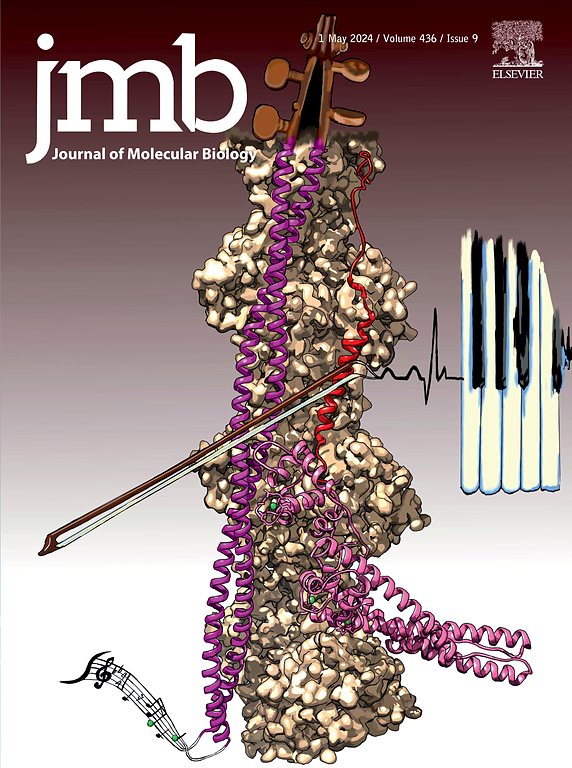TamL是拟杆菌属外膜稳态的关键分子。
IF 4.7
2区 生物学
Q1 BIOCHEMISTRY & MOLECULAR BIOLOGY
引用次数: 0
摘要
在变形菌中,外膜蛋白TamA和内膜锚定蛋白TamB形成易位和组装模块(TAM)复合体,促进自转运蛋白、毒力因子和可能的脂质在两层膜上的运输。在拟杆菌门中,TamA被TamL取代,TamL是一种类似TamA的脂蛋白,其n端有脂质修饰,可能将其固定在外膜上。这种结构上的差异表明,与TamA相比,TamL可能具有不同的功能。然而,TAM在变形菌门以外的细菌门中的作用仍未被探索。本研究旨在阐明TamL在环境类杆菌琼氏黄杆菌中的功能。与变形杆菌中的同源物不同,我们发现TamL和TamB在johnsoniae中是必需的。通过遗传、表型、蛋白质组学和脂质组学分析,我们发现TamL耗竭严重损害了外膜的完整性,表现为细胞活力降低、细胞形状改变、对膜破坏剂的易感性增加以及外膜脂蛋白水平升高。值得注意的是,我们没有观察到β-桶外膜蛋白水平的总体下降,也没有外膜脂质组成的实质性改变。通过下拉实验,我们发现TamL与TamB在约翰逊氏杆菌中共纯化,表明它们之间存在相互作用。此外,我们发现虽然TamL和TamB单顺反子基因在拟杆菌门中是保守的,但只有一些物种编码多个TamL、TamB和TamA蛋白。据我们所知,这项研究首次提供了对变形菌门之外的TAM亚基的功能见解。本文章由计算机程序翻译,如有差异,请以英文原文为准。

TamL is a Key Player of the Outer Membrane Homeostasis in Bacteroidota
In Proteobacteria, the outer membrane protein TamA and the inner membrane-anchored protein TamB form the Translocation and Assembly Module (TAM) complex, which facilitates the transport of autotransporters, virulence factors, and likely lipids across the two membranes. In Bacteroidota, TamA is replaced by TamL, a TamA-like lipoprotein with a lipid modification at its N-terminus that likely anchors it to the outer membrane. This structural difference suggests that TamL may have a distinct function compared to TamA. However, the role of TAM in bacterial phyla other than Proteobacteria remains unexplored.
Our study aimed to elucidate the function of TamL in Flavobacterium johnsoniae, an environmental Bacteroidota. Unlike its homologs in Proteobacteria, we found that TamL and TamB are essential in F. johnsoniae. Through genetic, phenotypic, proteomic, and lipidomic analyses, we show that TamL depletion severely compromises outer membrane integrity, as evidenced by reduced cell viability, altered cell shape, increased susceptibility to membrane-disrupting agents, and elevated levels of outer membrane lipoproteins. Notably, we did not observe an overall decrease in the levels of β-barrel outer membrane proteins, nor substantial alterations in outer membrane lipid composition.
By pull-down assays, we found TamL co-purifying with TamB in F. johnsoniae, suggesting an interaction. Furthermore, we found that while TamL and TamB monocistronic genes are conserved among Bacteroidota, only some species encode multiple TamL, TamB and TamA proteins.
To our knowledge, this study is the first to provide functional insights into a TAM subunit beyond Proteobacteria.
求助全文
通过发布文献求助,成功后即可免费获取论文全文。
去求助
来源期刊

Journal of Molecular Biology
生物-生化与分子生物学
CiteScore
11.30
自引率
1.80%
发文量
412
审稿时长
28 days
期刊介绍:
Journal of Molecular Biology (JMB) provides high quality, comprehensive and broad coverage in all areas of molecular biology. The journal publishes original scientific research papers that provide mechanistic and functional insights and report a significant advance to the field. The journal encourages the submission of multidisciplinary studies that use complementary experimental and computational approaches to address challenging biological questions.
Research areas include but are not limited to: Biomolecular interactions, signaling networks, systems biology; Cell cycle, cell growth, cell differentiation; Cell death, autophagy; Cell signaling and regulation; Chemical biology; Computational biology, in combination with experimental studies; DNA replication, repair, and recombination; Development, regenerative biology, mechanistic and functional studies of stem cells; Epigenetics, chromatin structure and function; Gene expression; Membrane processes, cell surface proteins and cell-cell interactions; Methodological advances, both experimental and theoretical, including databases; Microbiology, virology, and interactions with the host or environment; Microbiota mechanistic and functional studies; Nuclear organization; Post-translational modifications, proteomics; Processing and function of biologically important macromolecules and complexes; Molecular basis of disease; RNA processing, structure and functions of non-coding RNAs, transcription; Sorting, spatiotemporal organization, trafficking; Structural biology; Synthetic biology; Translation, protein folding, chaperones, protein degradation and quality control.
 求助内容:
求助内容: 应助结果提醒方式:
应助结果提醒方式:


